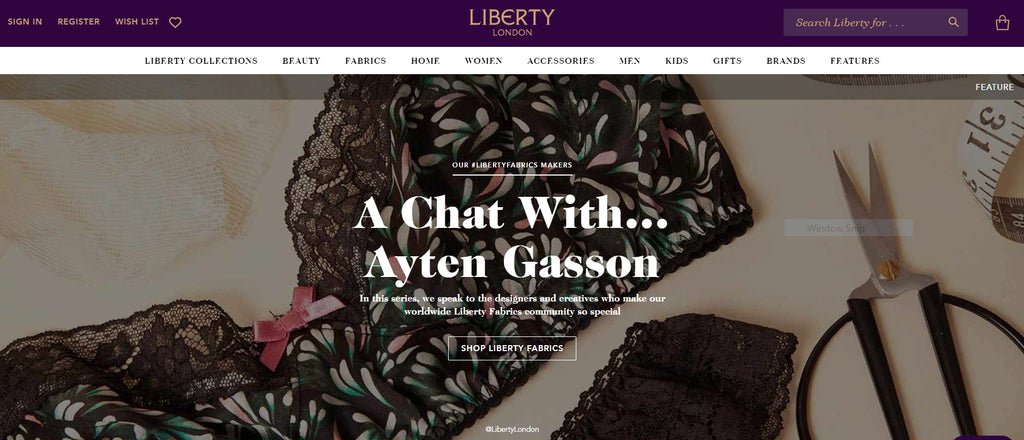
I pride myself on using the best quality fabrics and traditional techniques to make our lingerie. I love reading the amazing reviews and feedback my customers leave me and it makes all the hard work worthwhile. I was recently approached by Liberty London to be featured in their #libertymaker series, which spotlights designers using their luxurious printed silks. To be acknowledged by a company we have admired for so long has completely blown me away!
Thank you Liberty!
Shop our Liberty Collections here: https://www.aytengasson.com/collections/liberty-london-silk
You can read the interview on Liberty's website by following the link below:
https://
Across the globe @LibertyFabrics lovers are hard at work, creating a diverse array of pieces with our studio-painted designs as a canvas – and here at Liberty HQ, we love to spotlight the community’s unique creations. In this instalment of the series, we chat to Ayten Roberts about her Brighton-based lingerie label Ayten Gasson, with its focus on luxury, sustainability, and the importance of keeping intergenerational skills alive.
WHERE ARE YOU BASED, AND WHAT IS YOUR CREATIVE BACKGROUND?
My studio and lingerie boutique is based in Seven Dials in Brighton. I’m originally from London and grew up in Archway, which used to be home to a lot of garment factories – I think that’s why my love of fashion and textiles developed at such an early age.
I studied Fashion Print at Central Saint Martins and started my lingerie label, Ayten Gasson, in the summer of 2005. I was originally producing my pieces at a small factory in Wales and selling them to independent boutiques and department stores. But I found I was no longer making myself, which was always my passion – so I moved the business to Brighton and moved all my production in-house.
WHERE DO YOU DESIGN AND MAKE YOUR LINGERIE PIECES?
My studio is on the shop floor of my boutique. Sewing machines and fabrics are laid out alongside the finished pieces, so customers can easily see the entire creative process, how each piece is handmade and the quality of the fabrics. I have a large pattern-cutting table in the middle of the shop which is usually covered in laces, elastics and silk – I like seeing my patterns hanging alongside the lingerie.
WHY DO YOU CHOOSE TO WORK WITH LIBERTY FABRICS?
I love working with Liberty Fabrics because the quality is always outstanding. The vibrant colours pair perfectly with traditional prints inspired by some of my favourite artists, like William Morris. The drape on the silk satins is perfect for our bed jackets and robes. At the moment I really like Liberty’s Florus print, especially teamed with a lovely black Cluny cotton lace.
HOW DO YOU SOURCE YOUR MATERIALS?
My mother taught me the importance of good quality fabrics from an early age, and that knowledge was reinforced while at Central Saint Martins. There has been a lot of trial and error over the years – I’m now in my 15th year of business and feel I have now found the best places to source my materials. I mainly use 100% silk crepe-backed satin in my designs, and I enjoy working with Liberty’s Tana Lawn™ cotton alongside eco fabrics such as organic bamboo and cruelty-free organic peace silk.
The laces I choose to use are just as important as the main fabrics. I work closely with The Cluny Lace Company in Derbyshire, who have been producing lace since 1845 – the quality is exceptional. I also use vintage laces, which I find from visiting old factories and antique shops. I recently went over to Lille, and came back with a suitcase full of beautiful vintage French laces.
DO YOU HAVE A FAMILY HISTORY OF MAKING?
My mum worked as a sample machinist at home. By the age of eight I was helping ‘turn the loops’, which meant making rouleau straps for pocket money. I would sit in my mum's workroom surrounded by fabrics, using the offcuts to make outfits for my dolls. My Nene (grandmother in Turkish) worked in a factory at the end of the road. Originally a bomb factory during WWII, the building was filled with pattern cutters, machinists, steamers and garment packers in the late 80s and 90s. I remember being able to visit my Nene and watch as the garments were being made – I imagine health and safety wasn't as strict as it is today!
IS IT IMPORTANT TO YOU TO KEEP TRADITIONAL SKILLS ALIVE?
I grew up surrounded by factories, designers and makers but unfortunately witnessed the decline of the industry in the late 90s and early 2000s, as people sourced cheaper alternatives overseas. The skills I was taught at a young age are being lost – so yes, I feel it is important to keep them alive. It is better to buy a few well-made pieces than something that is cheaply and quickly made. Consumers understand the human and environmental cost that comes with mass-produced ‘fast fashion’ pieces.
WHAT STEPS DO YOU TAKE IN TERMS OF RESPONSIBLE PRODUCTION?
I try to live by an ethical, zero-waste policy in the shop. Small sections of fabric and lace are used for silk eye masks and lavender bags, while smaller offcuts are donated to local schools. When we make bespoke pieces, we’re often left with offcuts that are too small to make into a collection. These small amounts of vintage lace, elastic trims and silks are too beautiful not to use, so I introduced my limited-edition sale knickers to ensure nothing is wasted.
IS THERE AN EARLY LIBERTY MEMORY THAT YOU CAN SHARE WITH US?
Whilst working on my degree at Central Saint Martins I was only a five-minute walk from Liberty. Whenever I would feel uninspired or overwhelmed with my workload, I would walk though Soho and spend some time looking at the beautiful fabrics and trims. It was a form of escapism that I always found would help to get me back on track!





